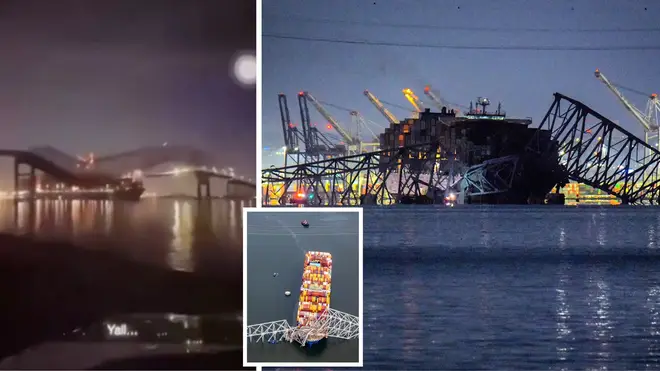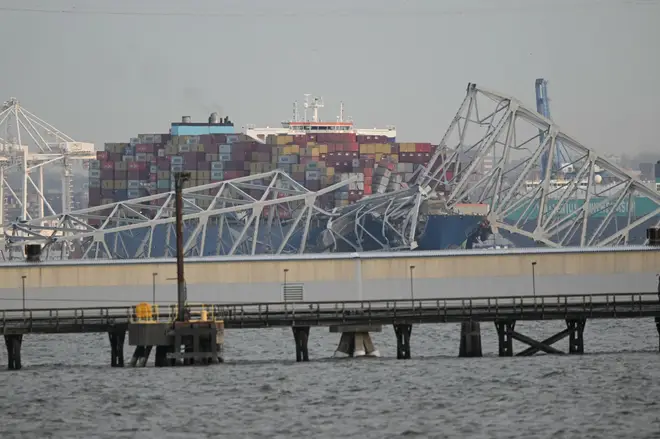
Oli Dugmore 4am - 7am
26 March 2024, 16:01 | Updated: 26 March 2024, 18:54

Harrowing close-up video footage has emerged of the moment Baltimore's Key Bridge collapsed after being struck by a container ship.
A desperate search is ongoing to try and trace six construction workers who plunged 185ft into the cold waters below the bridge.
They were repairing potholes on the bridge when it collapsed. The ship issued a mayday moments before the crash, meaning authorities were able to close off the bridge to regular traffic.
A state of emergency was declared on Tuesday morning following the catastrophic collision, which occurred at about 1.30am.
The ship, the Singaporean flagged Dali, was only 20 minutes into its journey when it slammed into a support column on the bridge.
US president Joe Biden posted on Twitter: “This morning, I convened senior members of my team for a briefing on the collapse of Baltimore's Francis Scott Key Bridge. I've directed my Administration to ensure every federal resource is available to assist search and rescue efforts and response to this terrible incident.”
The ship's crew has remained on board the cargo vessel, which remains marooned under the bridge, and are being questioned by members of the Coast Guard.
Read More: Two pulled from water after Baltimore bridge hit by cargo ship collapses
During an early morning press conference at around 6:30 am, Baltimore Fire Chief James Wallace was only able to confirm that two people were pulled from the water.

Two pulled from water after Baltimore bridge hit by cargo ship collapses
One was unhurt, the other had to be rushed to a local hospital with "serious injuries".
It was not immediately clear what caused the cargo ship to crash into the bridge. The FBI has not ruled out terrorism.
One local official described the collision as a "developing mass casualty event."

The rescue effort incorporates Coast Guard ships, local police boats, Baltimore's Fire Department, volunteer fire departments from the surrounding areas as well as teams of divers as the desperate search for survivors goes on.
According to an early Cybersecurity and Infrastructure Security Agency (CISA) report, the container ship "lost propulsion" as it was leaving port.
"The vessel notified MD Department of Transportation (MDOT) that they had lost control of the vessel and an allision with the bridge was possible," the report said.
"The vessel struck the bridge causing a complete collapse."

Dr Nii Attoh-Okine from Maryland University speaks to LBC as 6 remain missing after bridge collapse
The ship crashed into one of the bridge’s supports, causing the structure to snap and buckle at several points and tumble into the water in a matter of seconds — a shocking spectacle that was captured on video and posted on social media.
The vessel caught fire billowing thick black smoke out of its wreck.
There appeared to be an explosion on the container ship as it collided with the bridge sending container and diesel flooding into the water. One of the vehicles that fell to the water was a tractor-trailer.
The ship involved is the 948 foot long Dali, a Singaporean-flagged container bound for Colombo, Sri Lanka. It could be seen on ship tracking websites positioned stationary under the bridge following the crash.
It left Baltimore's Seagirt Marine Terminal at 12:24am. At 1:25am, is began to slow and diverted off of its course. The video shows lights going off on board just before the crash.

Graphic shows location of collapsed bridge in Baltimore
It's unclear what cargo the Dali was holding. According to the ship's owners, all crew members were accounted for with no injuries reported.
Around 30,000 vehicles use the bridge, which is named for the writer of the Star Spangled Banner, every day. It opened in 1977.
Sonar has indicated that there are vehicles in the water, where the temperature was about 47 degrees Fahrenheit in the early hours of Tuesday, according to a buoy that collects data for the National Oceanic and Atmospheric Administration.